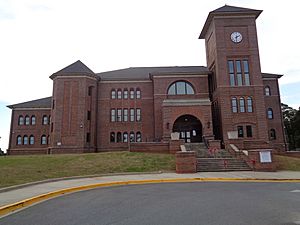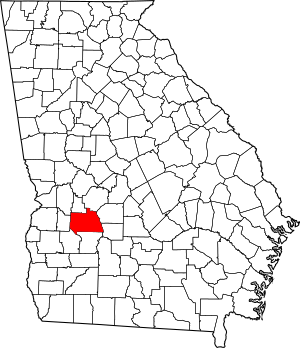Sumter County, Georgia facts for kids
Quick facts for kids
Sumter County
|
|||
|---|---|---|---|

Sumter County Courthouse in Americus
|
|||
|
|||

Location within the U.S. state of Georgia
|
|||
 Georgia's location within the U.S. |
|||
| Country | |||
| State | |||
| Founded | December 26, 1831 | ||
| Named for | Thomas Sumter | ||
| Seat | Americus | ||
| Largest city | Americus | ||
| Area | |||
| • Total | 493 sq mi (1,280 km2) | ||
| • Land | 483 sq mi (1,250 km2) | ||
| • Water | 10 sq mi (30 km2) 2.0%% | ||
| Population
(2020)
|
|||
| • Total | 29,616 | ||
| • Density | 61/sq mi (24/km2) | ||
| Time zone | UTC−5 (Eastern) | ||
| • Summer (DST) | UTC−4 (EDT) | ||
| Congressional district | 2nd | ||
Sumter County is a county located in the west-central part of the U.S. state of Georgia. In 2020, about 29,616 people lived there. The main town and county seat is Americus. The county was officially created on December 26, 1831.
Sumter County is also part of the Americus micropolitan statistical area. This means it's connected to Americus for things like jobs and daily life.
Contents
Discover Sumter County's Past
How Sumter County Began
Sumter County was created by the state government on December 26, 1831. This happened after the Creek Indians moved from the area. The state of Georgia got this land from them in 1825. Sumter was the 80th county in Georgia. It was formed by splitting off a part of Lee County, which is now to its south.
The county was named after Thomas Sumter (1734–1832). He was a general and a U.S. Senator from South Carolina. When Sumter County was formed, Thomas Sumter was 97 years old. He was the last general from the American Revolution (1775–1783) who was still alive.
Soon after, a group of people chose a central spot for the county's main town. They planned out what became the town of Americus. Many of the first white settlers got their land through a state land lottery in 1827. These settlers quickly started growing cotton on their new land. Cotton became a very important crop in the South after the cotton gin was invented.
The rich, dark soil in Sumter County was perfect for growing cotton. The county also had easy access to markets. This was thanks to the Flint River on its east side and the Chattahoochee River further west. Because of this, Sumter County became one of the richest cotton-growing areas by the 1840s and 1850s.
Growing cotton back then relied on the forced labor of African Americans. By 1850, the county had 6,469 white people, 3,835 enslaved African Americans, and 18 free people of color. By 1860, there were 4,536 white people, 4,890 enslaved African Americans, and two free people of color.
Sumter County During the Civil War
During the American Civil War (1861–65), a small village called Andersonville was chosen for a prisoner-of-war camp. This village is about 9 miles (14 km) north of Americus. The Andersonville prison was built in nearby Macon County. It became the largest prison of its kind in the South.
Over 14 months, about 45,000 Union prisoners were held there. They faced very harsh conditions, and many died. Today, the Andersonville National Historic Site remembers all American prisoners of war. This park covers 495 acres (2 km2) and is in both Macon and Sumter Counties. It includes the old prison site and a cemetery for Union soldiers who died there.
Sumter County in Modern Times
Sumter County has also been important for other reasons in the 20th century. In 1942, two Baptist ministers started a Christian community called Koinonia. It was on a farm in the western part of the county. Black and white workers lived and worked together there for almost 50 years. This caused some challenges with local residents in the early years.
A U.S. president was born and grew up in Sumter County. Jimmy Carter was raised on a peanut farm in Plains. This is a small community on the western side of the county. When he was elected president in 1976, Plains became very famous. Journalists and tourists still visit the town. The Carters lived in Plains until their deaths, and much of their family still lives there. Jimmy Carter's birthplace and childhood home are now a National Historic Site. You can take tours there.
The main office for Habitat for Humanity International is in Americus. This group helps end homelessness by building homes for people. Its founder, Millard Fuller, was from Americus. Koinonia Partners also publishes a newsletter that helps with prisoner reform and education.
Americus is home to two colleges. Georgia Southwestern State University is a public four-year school. It was started in 1906 and is part of the University System of Georgia. South Georgia Technical College is near Souther Field. Souther Field was a training base for American and British pilots during World War I (1917–18). Famous pilot Charles Lindbergh learned to fly there. He also put together a military airplane with help from mechanics at Souther Field.
Downtown Americus has two beautiful old buildings that have been restored. These are the Windsor Hotel, built in 1892, and the Rylander Theatre, which opened in 1921.
Exploring Sumter County's Geography
Sumter County covers about 493 square miles (1,277 km2). Most of this is land, about 483 square miles (1,251 km2). About 10 square miles (26 km2) or 2.0% is covered by water.
Muckalee Creek flows through Sumter County. The county also has Lake Blackshear and Kinchafoonee Creek.
The western two-thirds of Sumter County is in the Kinchafoonee-Muckalee subbasin. This area stretches from northeast of Americus to southwest of Leslie. The eastern third of the county is in the Middle Flint River subbasin. Both of these are part of the larger Apalachicola-Chattahoochee-Flint River Basin.
Main Roads in Sumter County
Neighboring Counties
- Macon County (northeast)
- Dooly County (east)
- Crisp County (southeast)
- Lee County (south)
- Terrell County (southwest)
- Webster County (west)
- Marion County (northwest)
- Schley County (north)
Protected Areas to Visit
Communities in Sumter County
Cities
- Americus (the county seat)
- Andersonville
- De Soto
- Leslie
- Plains
Unincorporated Community
People of Sumter County
| Historical population | |||
|---|---|---|---|
| Census | Pop. | %± | |
| 1840 | 5,759 | — | |
| 1850 | 10,322 | 79.2% | |
| 1860 | 9,428 | −8.7% | |
| 1870 | 16,559 | 75.6% | |
| 1880 | 18,239 | 10.1% | |
| 1890 | 22,107 | 21.2% | |
| 1900 | 26,212 | 18.6% | |
| 1910 | 29,092 | 11.0% | |
| 1920 | 29,640 | 1.9% | |
| 1930 | 26,800 | −9.6% | |
| 1940 | 24,502 | −8.6% | |
| 1950 | 24,208 | −1.2% | |
| 1960 | 24,652 | 1.8% | |
| 1970 | 26,931 | 9.2% | |
| 1980 | 29,360 | 9.0% | |
| 1990 | 30,228 | 3.0% | |
| 2000 | 33,200 | 9.8% | |
| 2010 | 32,819 | −1.1% | |
| 2020 | 29,616 | −9.8% | |
| 2023 (est.) | 28,890 | −12.0% | |
| U.S. Decennial Census 1790-1880 1890-1910 1920-1930 1930-1940 1940-1950 1960-1980 1980-2000 2010 2020 |
|||
| Race / Ethnicity (NH = Not Hispanic) | Pop 2000 | Pop 2010 | Pop 2020 | % 2000 | % 2010 | % 2020 |
|---|---|---|---|---|---|---|
| White alone (NH) | 15,672 | 13,413 | 11,528 | 47.20% | 40.87% | 38.92% |
| Black or African American alone (NH) | 16,196 | 16,894 | 15,051 | 48.78% | 51.48% | 50.82% |
| Native American or Alaska Native alone (NH) | 73 | 95 | 40 | 0.22% | 0.29% | 0.14% |
| Asian alone (NH) | 193 | 418 | 503 | 0.58% | 1.27% | 1.70% |
| Pacific Islander alone (NH) | 6 | 9 | 4 | 0.02% | 0.03% | 0.01% |
| Other race alone (NH) | 10 | 12 | 55 | 0.03% | 0.04% | 0.19% |
| Mixed race or Multiracial (NH) | 159 | 261 | 665 | 0.48% | 0.80% | 2.25% |
| Hispanic or Latino (any race) | 891 | 1,717 | 1,770 | 2.68% | 5.23% | 5.98% |
| Total | 33,200 | 32,819 | 29,616 | 100.00% | 100.00% | 100.00% |
In 2020, there were 29,616 people living in Sumter County. There were 11,510 households and 7,256 families.
Sumter County's Economy
Sumter County is still mostly a rural area. Farming is very important here. Cotton is the biggest crop, with about 35,000 acres (142 km2) of land used to grow it. Other important crops are wheat, peanuts, and corn.
Some of the biggest employers in the county include Cooper Lighting, Georgia Southwestern State University, Magnolia Manor, Phoebe Sumter Medical Center, and Walmart.
Education in Sumter County
The Sumter County School District runs the public schools in the area.
There is also a private school in Americus called Southland Academy.
See also
 In Spanish: Condado de Sumter (Georgia) para niños
In Spanish: Condado de Sumter (Georgia) para niños


